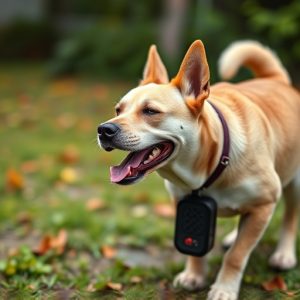Handheld Bark Control Devices: Effective Carrying & Safety Tips
Handheld dog deterrents using ultrasonic technology offer a safe, humane way to manage excessive bar…….
Handheld dog deterrents using ultrasonic technology offer a safe, humane way to manage excessive barking. These portable devices can be effectively carried in ergonomic pouches or belt clips for quick access during walks and training sessions. By selecting models with adjustable settings, automatic shut-off, and positive user reviews, owners can safely address unwanted canine behavior up to 5-10 meters away, while respecting local laws and following consistent targeting and patient usage for optimal effectiveness.
Introducing our comprehensive guide on handheld sonic bark control devices, a revolutionary tool for pet owners seeking effective dog deterrent methods. This article explores the power of sound to train and calm dogs, offering an alternative to traditional training techniques. We delve into the benefits, from reduced barking to improved behavior, and provide crucial insights on selecting the best device, considering various carrying methods to suit different needs. Discover safety precautions and tips for optimal use, ensuring a harmonious coexistence with your furry friend.
- Understanding Handheld Sonic Bark Control Devices
- Benefits of Using Dog Deterrent Devices
- Different Carrying Methods for Handheld Devices
- Selection Criteria for the Best Handheld Bark Control Device
- Safety Precautions and Effective Use Tips
Understanding Handheld Sonic Bark Control Devices
Handheld sonic bark control devices are innovative tools designed to address excessive dog barking through non-lethal means. These portable devices emit high-frequency sound waves that are unpleasant to dogs, deterring them from barking without causing harm or stress. Understanding how these devices work and their effective carrying methods is essential for responsible pet ownership.
Handheld dog deterrents typically operate on simple principles, using ultrasonic technology to detect and respond to dog barking. They can be carried in convenient, ergonomic designs that allow users to easily transport them during walks or training sessions. Effective carrying methods involve keeping the device readily accessible—either in a dedicated pouch or belt clip—to ensure quick deployment when needed. This approach promotes responsible intervention without causing undue distress to the animal.
Benefits of Using Dog Deterrent Devices
Using handheld dog deterrent devices offers numerous benefits for both pet owners and their furry friends. One of the primary advantages is their portability, allowing users to carry them in convenient handheld forms. This mobility enables on-the-go training sessions and immediate intervention when faced with unwanted behaviors, such as barking or aggression. By having a device readily available, owners can correct problematic actions swiftly, potentially preventing more severe issues from developing.
Additionally, these devices often utilize safe and effective methods to deter dogs without causing harm. Many models emit ultrasonic sounds or use vibration technology, which are inaudible to humans but can be irritating to canines, encouraging them to stop barking or exhibit unwanted behaviors. This non-violent approach ensures the well-being of both the pet and its owner, fostering a positive training environment.
Different Carrying Methods for Handheld Devices
Carrying a handheld sonic bark control device efficiently involves considering various methods to ensure comfort and ease of use during walks with your pet. One popular approach is to utilize a secure belt clip, allowing you to attach the device securely to your belt loop or waistband. This method keeps your hands free while providing quick access, making it ideal for active individuals who need constant control while on the go.
Alternatively, a lanyard or leash attachment offers another practical solution. By attaching the device to a dog leash or around your neck, you maintain close proximity and control during walks. This carrying method is beneficial for those who prefer hands-free exploration or want to keep their device within easy reach at all times. These different carrying options cater to diverse user preferences and activity levels, ensuring comfort and convenience while addressing unwanted canine behavior.
Selection Criteria for the Best Handheld Bark Control Device
When choosing a handheld bark control device, several key factors come into play to ensure its effectiveness and safety. Firstly, consider carrying methods – some devices are designed for ease of use with features like ergonomic handles and lightweight designs, making them convenient for quick interventions during dog misbehavior. Secondly, the range is critical; opt for models offering a suitable distance to manage barking without causing distress or discomfort to the animal from afar.
Additionally, handheld dog deterrents vary in their operating modes and sound intensities. It’s important to select a device with adjustable settings to tailor the response to different barking scenarios. Some devices incorporate safety features like automatic shut-off mechanisms and customizable frequency ranges to minimize potential harm or annoyance to both pet and surroundings. Lastly, user reviews and reliability are essential; seek out products from reputable brands with positive feedback for consistent performance in various situations.
Safety Precautions and Effective Use Tips
When using a handheld sonic bark control device, safety precautions are paramount. Always ensure that the device is aimed directly at the barking dog, avoiding pets, children, or anyone else nearby to prevent any potential harm from the high-frequency sound waves. It’s crucial to follow manufacturer guidelines regarding safe usage and distance, typically within 5–10 meters (16–33 feet) for effective control without causing discomfort. Familiarize yourself with local laws and regulations regarding noise levels and animal control devices before deployment.
For optimal effectiveness, consider these tips: consistently target the barking dog to reinforce the device’s sound; maintain a consistent carrying method, such as securing the device in a dedicated pouch or holster to ensure quick access during walks; and be patient—it may take multiple applications for the dog to associate their barking with the sonic deterrent. Regular usage in controlled scenarios can help minimize false triggers while training your pet to recognize and respond appropriately to the sound.
Handheld sonic bark control devices offer a non-lethal, effective solution for managing excessive dog barking. By understanding their operation, benefits, and proper use, owners can effectively address behavior issues while maintaining their pets’ safety and well-being. When selecting the best device, consider factors like range, decibel level, and carrying methods, such as belts or lanyards, to ensure convenient and responsible control. Remember to always follow safety precautions, use these tools responsibly, and consult with a veterinarian or professional trainer for the best results.


